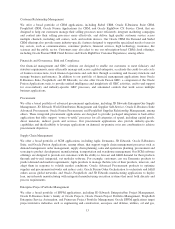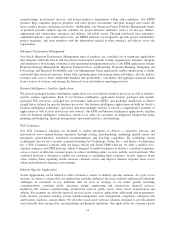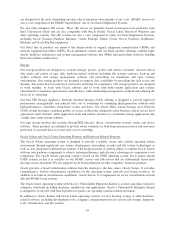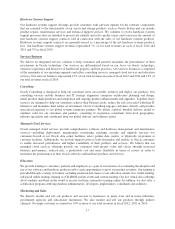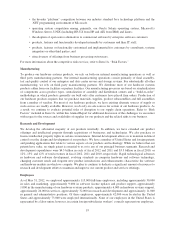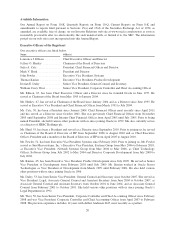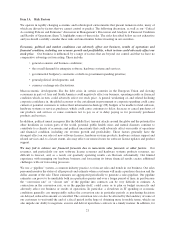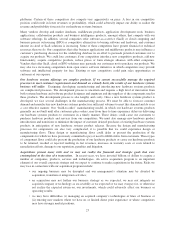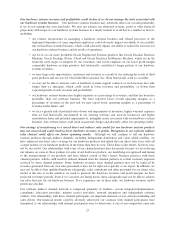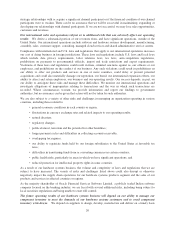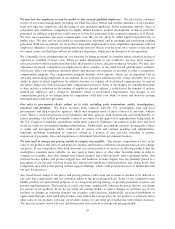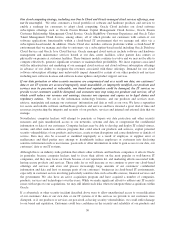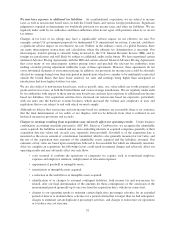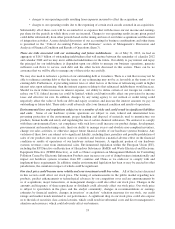Oracle 2012 Annual Report Download - page 27
Download and view the complete annual report
Please find page 27 of the 2012 Oracle annual report below. You can navigate through the pages in the report by either clicking on the pages listed below, or by using the keyword search tool below to find specific information within the annual report.platforms. Certain of these competitors also compete very aggressively on price. A loss in our competitive
position could result in lower revenues or profitability, which could adversely impact our ability to realize the
revenue and profitability forecasts for our hardware systems business.
Many vendors develop and market databases, middleware products, application development tools, business
applications, collaboration products and business intelligence products, amongst others, that compete with our
software offerings. In addition, several companies offer software-as-a-service (SaaS) or cloud computing and
business process outsourcing (BPO) as competitive alternatives to buying software and hardware, and customer
interest in cloud or SaaS solutions is increasing. Some of these competitors have greater financial or technical
resources than we do. Our competitors that offer business applications and middleware products may influence a
customer’s purchasing decision for the underlying database in an effort to persuade potential customers not to
acquire our products. We could lose customers if our competitors introduce new competitive products, add new
functionality, acquire competitive products, reduce prices or form strategic alliances with other companies.
Vendors that offer SaaS, cloud or BPO solutions may persuade our customers not to purchase our products. We
may also face increasing competition from open source software initiatives in which competitors may provide
software and intellectual property for free. Existing or new competitors could gain sales opportunities or
customers at our expense.
Our hardware systems offerings are complex products. If we cannot successfully manage the required
processes to meet customer requirements and demand on a timely basis, the results of our hardware systems
business will suffer. Designing, developing, manufacturing and introducing new hardware systems products
are complicated processes. The development process is uncertain and requires a high level of innovation from
both systems hardware and software product designers and engineers and the suppliers of the components used in
these products. The development process is also lengthy and costly. Once a new hardware systems product is
developed, we face several challenges in the manufacturing process. We must be able to forecast customer
demand and manufacture new hardware systems products in sufficient volumes to meet this demand and do so in
a cost effective manner. Our “build-to-order” manufacturing model, in which our hardware systems products
generally are not built until after customers place orders, may from time to time experience delays in delivering
our hardware systems products to customers in a timely manner. These delays could cause our customers to
purchase hardware products and services from our competitors. We must also manage new hardware product
introductions and transitions to minimize the impact of customer delayed purchases of existing hardware systems
products in anticipation of new hardware systems product releases. Because the design and manufacturing
processes for components are also very complicated, it is possible that we could experience design or
manufacturing flaws. These design or manufacturing flaws could delay or prevent the production of the
components for which we have previously committed to pay or need to fulfill orders from customers. These types
of component flaws could also prevent the production of our hardware products or cause our hardware products
to be returned, recalled or rejected resulting in lost revenues, increases in warranty costs or costs related to
remediation efforts, damage to our reputation, penalties and litigation.
Acquisitions present many risks and we may not realize the financial and strategic goals that were
contemplated at the time of a transaction. In recent years, we have invested billions of dollars to acquire a
number of companies, products, services and technologies. An active acquisition program is an important
element of our overall corporate strategy and we expect to continue to make acquisitions in the future. Risks we
may face in connection with our acquisition program include:
• our ongoing business may be disrupted and our management’s attention may be diverted by
acquisition, transition or integration activities;
• an acquisition may not further our business strategy as we expected, we may not integrate an
acquired company or technology as successfully as we expected or we may overpay for, or otherwise
not realize the expected return on, our investments, which could adversely affect our business or
operating results;
• we may have difficulties (i) managing an acquired company’s technologies or lines of business or
(ii) entering new markets where we have no or limited direct prior experience or where competitors
may have stronger market positions;
23


